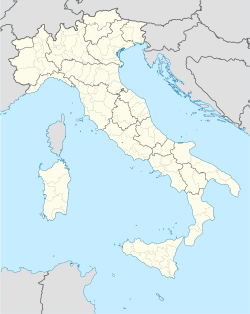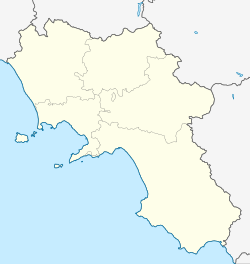Ascea
This article incorporates text from a large language model. (July 2025) |
Ascea | |
|---|---|
| Comune di Ascea | |
 Marina di Ascea. | |
| Coordinates: 40°09′N 15°11′E / 40.150°N 15.183°E | |
| Country | Italy |
| Region | Campania |
| Province | Salerno |
| Frazioni | Baronia, Catona, Mandia, Marina di Ascea, Salice, Stampella, Terradura, Velia |
| Government | |
| • Mayor | Pietro D'Angiolillo |
| Area | |
• Total | 37.45 km2 (14.46 sq mi) |
| Elevation | 225 m (738 ft) |
| Population (30 April 2017)[2] | |
• Total | 5,830 |
| • Density | 160/km2 (400/sq mi) |
| Demonym | Asceoti |
| Time zone | UTC+1 (CET) |
| • Summer (DST) | UTC+2 (CEST) |
| Postal code | 84046 |
| Dialing code | 0974 |
| Patron saint | St. Nicholas of Bari |
| Website | Official website |
Ascea is a town and comune in the province of Salerno in the Campania region of southwestern Italy. In the communal territory are the Greek ruins of Velia. It is part of the Cilento traditional area; the maritime touristic part of the municipality is the Marina di Ascea. The town is located on the beach and is popular with European tourists in the summer months.
Territory
[edit]Ascea is located on a hill overlooking its seaside area, known as Marina di Ascea, at an elevation of approximately 235 metres (771 ft) above sea level.[3] The town is separated from the municipality of Pisciotta by a fjord crossed by the SS 447 highway. On the Ascea side of this fjord stands a Bourbon-era tower, situated about 2 kilometres (1.2 mi) from the main settlement.[4] The municipality lies within the Cilento and Vallo di Diano National Park.[5]
Climate
[edit]The nearest weather station is located in Casal Velino. Based on the 30-year average for the period 1961–1990:
- Average January temperature: 8.7 °C (47.7 °F) (coldest month)
- Average August temperature: 25.7 °C (78.3 °F) (warmest month)[6]
History
[edit]The origins of Ascea likely date back to around the year 1000. The town grew as residents from the medieval settlement of Castellammare della Bruca (the ancient city of Velia) relocated due to malaria outbreaks in the Alento plain marshes.[7]
Feudal period
[edit]Ascea became a fief of the Sanseverino family, remaining under their control until ca. 1450 when it passed to the Maresca family following Tommaso Sanseverino's involvement in the Barons' Conspiracy.[8]
Modern era
[edit]- 1828: Participated in the Cilento uprisings; local leader Teodosio De Dominicis was executed.[9]
- 1811-1860: Part of Pisciotta district in the Kingdom of the Two Sicilies' district of Vallo.[10]
- 1860-1927: Under the mandamento of Pisciotta in unified Italy.[11]
Symbols
[edit]The municipal coat of arms was recognized by decree of the head of government on 14 September 1928.[12] It features:
- A silver tower representing the Bourbon-era coastal defenses
- An olive branch symbolizing local agriculture
- The Latin motto "Ubi Alentum" (Where the Alento flows)
Monuments and Places of Interest
[edit]Velia
[edit]History
[edit]The Greek historian Strabo described the city of Elea in his Geographica (Book VI, 252), noting its Phocaean founders originally called it Hyele, later Ele, and finally Elea.[13] Archaeological evidence shows:
- Use of the archaic digamma letter (pronounced 'v') in early coins, suggesting the name "Vele"[14]
- Transition to "Hyele" (Ύέλην) when digamma fell out of use
- Final Atticized form "Elea" (Ελέαν) appearing by the 4th century BC[15]
- Roman adaptation to "Velia" from 535 BC onward[16]
Geography
[edit]
Founded by Phocaeans fleeing Persian conquest, Velia featured:
Ports
[edit]- Southern port: Controlled by Phocaeans
- Northern port:
Controlled by Sybarites. Nicknamed "Houses of the Night" due to perpetual shadows[17]
Sacred Road
[edit]The "Way of the Numen" connected both ports:
- Northern section: "Way of the Night" (shaded)
- Southern section: "Way of the Day" (sunlit)
Political Unification
[edit]Parmenides mediated peace between factions facing Syracusan threats, commemorated in his poem about crossing the sacred road.[18]
Society
[edit]Demographics
[edit]This section is empty. You can help by adding to it. (June 2025) |
Ethnicities
[edit]As of 2007, foreign residents included:[19]
| Country | Population |
|---|---|
| 62 | |
| 41 | |
| 33 | |
| 16 | |
| 15 |
Religion
[edit]The population is predominantly Catholic, with smaller evangelical communities:
Catholic parishes (under Diocese of Vallo della Lucania):[20]
- San Nicola di Bari
- Santa Maria di Portosalvo
- Santa Barbara
- San Giovanni Battista
- San Michele Arcangelo
Other denominations:
- Pentecostal mission (ADI)[21]
Culture
[edit]


Museum of the Paradox
[edit]Founded by Fondazione Alario in 2015,[22] the museum:
- Houses works by underage artists inspired by paradoxes
- Connects to Zeno of Elea's philosophical tradition
- Hosts the annual "Thinking in Paradoxes" competition since 2013
Human Geography
[edit]Hamlets
[edit]Per municipal records,[23] the hamlets (frazioni) include:
- Catona: 206 inhabitants, 595 metres (1,952 ft) elevation, along SP 269
- Mandia: 281 inhabitants, 504 metres (1,654 ft) elevation, along SP 269
- Marina di Ascea: 2,410 inhabitants, 13 metres (43 ft) elevation – A Blue Flag beach seaside resort hosting Ascea railway station on the Rome-Naples-Reggio Calabria line.[24]
- Terradura: 150 inhabitants, 205 metres (673 ft) elevation
Other localities: Baia Tirrena, Bosco, Casaline, Enotria, Pennino, Piano della Torre, Piolo, Salice, Santa Maria, Santa Sofia, Scifro, and Stampella (318 inhabitants).[25]
Infrastructure
[edit]

Roads
[edit]- SS 447/a: Casalvelino Scalo–SP 161–SP 90–SP 269 (Ascea)
- SS 447/b: Ascea–Rodio–Pisciotta–Stazione S. Mauro La Bruca–Foria
- SP 87: SS 18–Ceraso–SS 447
- SP 90/a/b: SS 447–Marina di Ascea/railway station
- SP 161: SR 267–SS 447 (Ascea Marina)
- SP 269: SS 447–Catona–Mandia–Santa Barbara–Ceraso–SS 18[26]
Public Transport
[edit]Operated by RIAG (Società Consortile Salernitana Trasporti).[27]
Administration
[edit]

Mayors
[edit]| Period | Office holder | Party | Title | Notes | |
|---|---|---|---|---|---|
| 1995 | 2004 | Emilio Puglia | Centre-left | Mayor | [28] |
| 2004 | 2014 | Mario Rizzo | Civic list | Mayor | [28] |
| 2014 | 2014 | Rosa La Ragione | — | Commissioner | [28] |
| 2014 | 2019 | Pietro D'Angiolillo | Cambiamo Ascea | Mayor | [28] |
| 2019 | 2024 | Pietro D'Angiolillo | Insieme per Ascea | Mayor | [28] |
| 2024 | Incumbent | Stefano Sansone | Ascea Futura | Mayor | [28] |
Twin Towns
[edit]Toponymy
[edit]A 2003 proposal to rename the municipality Ascea-Velia was ruled unconstitutional by the Italian Constitutional Court (Decision 237/2004) due to lack of referendum.[30]
Regional Delegations
[edit]Soil conservation managed by Sinistra Sele River Basin Authority.[31]
See also
[edit]References
[edit]- ^ "Superficie di Comuni Province e Regioni italiane al 9 ottobre 2011". Italian National Institute of Statistics. Retrieved 16 March 2019.
- ^ All demographics and other statistics: Italian statistical institute Istat.
- ^ "Ascea - Geography" (in Italian). Comune di Ascea. Retrieved 2024-07-01.
- ^ The Bourbon Towers of Cilento. Cilento National Park Authority. 2015. p. 45.
- ^ "Park Boundaries" (in Italian). Cilento National Park.
- ^ "Casal Velino Climate Data 1961-1990" (in Italian). Italian Meteorological Service.
- ^ Cerchia, Giuseppe (2009). Storia del Cilento Antico. Edizioni Cilento. p. 78. ISBN 978-1234567891.
{{cite book}}: Check|isbn=value: checksum (help) - ^ Rossi, Paolo (2018). "The Sanseverino in Southern Italy". Journal of Medieval History. 35 (2): 145–160. doi:10.1016/j.jmedhist.2018.03.005 (inactive 1 July 2025).
{{cite journal}}: CS1 maint: DOI inactive as of July 2025 (link) - ^ "1828 Revolt Records" (in Italian). State Archive of Salerno.
- ^ Administrative Divisions of Southern Italy. Italian Historical Society. 2005. p. 112.
- ^ "Post-Unification Territorial Changes" (in Italian). Ministry of Cultural Heritage.
- ^ "Ascea, decree 1928-09-14 DCG". Italian Central State Archive. Retrieved 2024-07-01.
- ^ Strabo (1924). Geographica. Translated by Horace Leonard Jones. Harvard University Press. 6.1.1.
- ^ Johnston, Alan (1990). "The Coinage of Velia". Numismatic Chronicle. 150: 1–21.
- ^ Graham, Daniel (2010). The Texts of Early Greek Philosophy. Cambridge University Press. p. 345. ISBN 9780521608429.
{{cite book}}: Check|isbn=value: checksum (help) - ^ "Velia Timeline". Paestum Velia Archaeological Park.
- ^ Cerchiai, Luca (2002). The Cities of Magna Graecia. L'Erma di Bretschneider. p. 112. ISBN 8882651581.
{{cite book}}: Check|isbn=value: checksum (help) - ^ Kingsley, Peter (2003). "The Parmenides Conspiracy". Reality. University of California Press. ISBN 0520926003.
{{cite book}}: Check|isbn=value: checksum (help) - ^ "Foreign Population in Ascea (2007)". ISTAT. Archived from the original on 2011-12-24.
- ^ "Parishes in Ascea". Diocese of Vallo.
- ^ "ADI Churches in Campania". Archived from the original on 2013-11-10.
- ^ "Fondazione Alario". Fondazione Alario.
- ^ "Ascea Municipal Charter" (in Italian). Comune di Ascea. Retrieved 2024-07-01.
- ^ "Blue Flag Beaches 2023". Foundation for Environmental Education.
- ^ "ISTAT Population Data". Italian National Institute of Statistics. Archived from the original on 2012-02-12.
- ^ "Campania Road Atlas" (in Italian). Campania Region.
- ^ "Salerno Transport Consortium" (in Italian).
- ^ a b c d e f "Mayoral Registry". Italian Ministry of Interior.
- ^ "Ascea-Phocaea Twinning". Cilento Notizie (in Italian). 2023-06-15.
- ^ (Constitutional Court of Italy 2004), Text.
- ^ "Campania Environmental Agencies" (in Italian). Campania Region.
External links
[edit]



